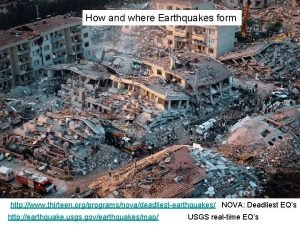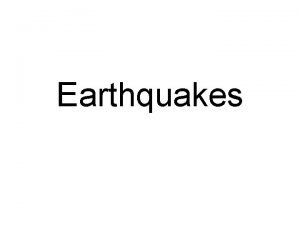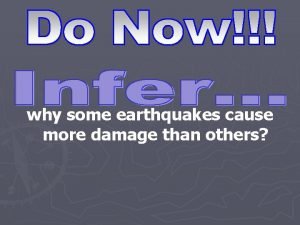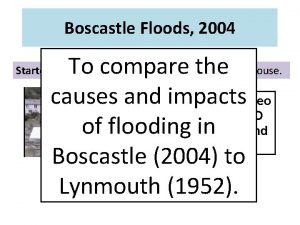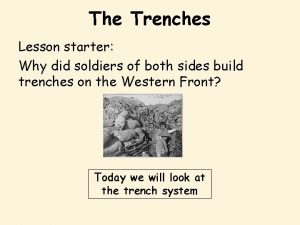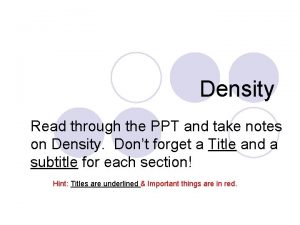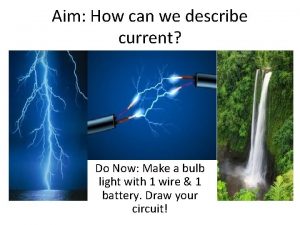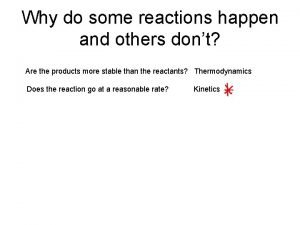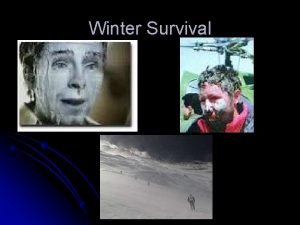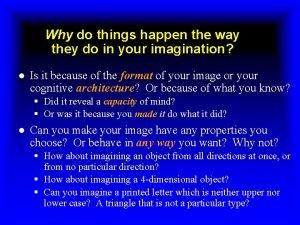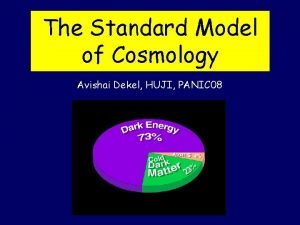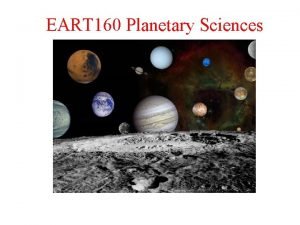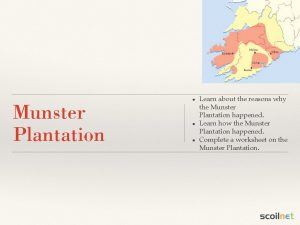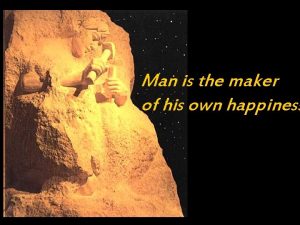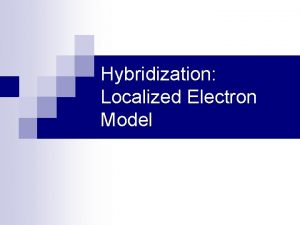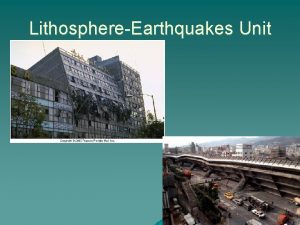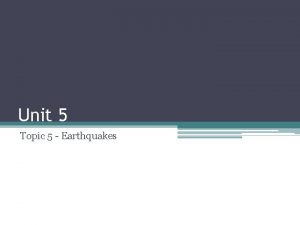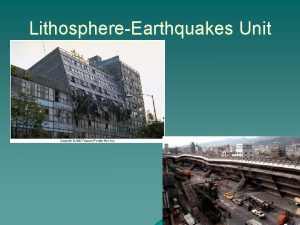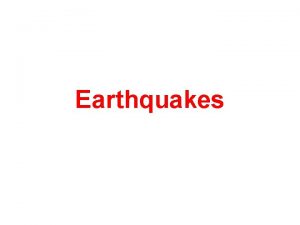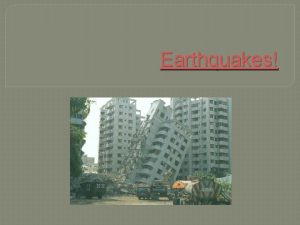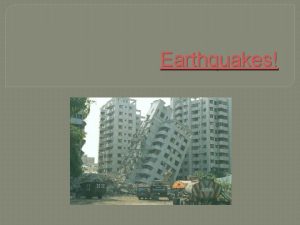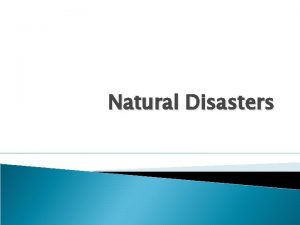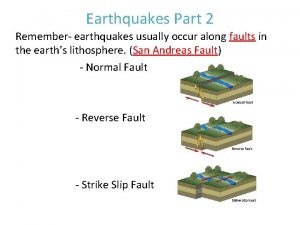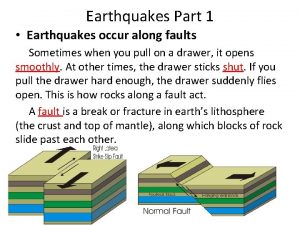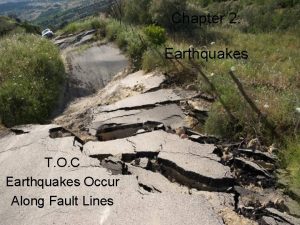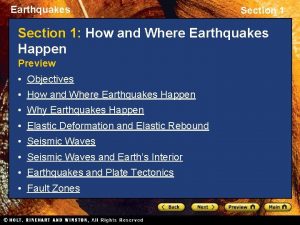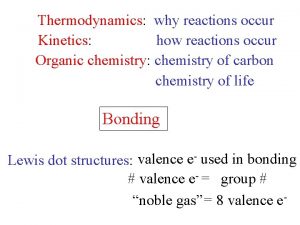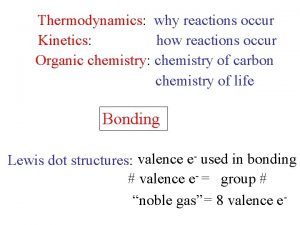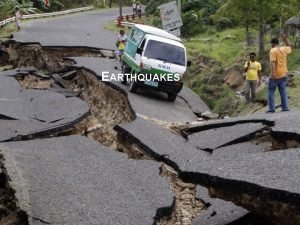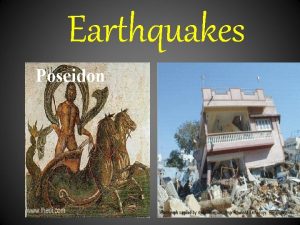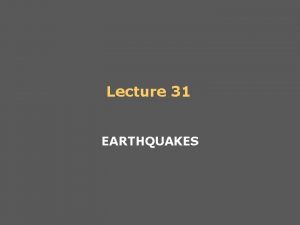LithosphereEarthquakes Unit Why earthquakes happen u Earthquakes occur





























- Slides: 29

Lithosphere-Earthquakes Unit

Why earthquakes happen? u Earthquakes occur when rocks fracture, or break, deep within Earth u Fractures form when stress exceeds the strength of the rocks involved

Three Types of Stress compression-decreases volume tension-pulls apart shear-twists material

Elastic Rebound Stress causes the ground begins to be deformed. An earthquake occurs when a rock passes its point of maximum elasticity. After it breaks, it regains its original shape (but not position. )

Faults u Many rocks fail when stress is applied too quickly or when stress is great u Resulting fracture along which movement occurs is called a fault

Three Types of Faults Reverse faults – form due to compression, shortens crust Normal faults – form due to tension extends crust Strike-slip faults – form due to shear

Faults

Focus and Epicenter Focus – where the fracture occurs to cause an earthquake, beneath Earth’s surface; the closer focus is to Earth’s surface, the more severe the damage is to be expected. Epicenter – the spot on the surface above the focus

Seismograph A device used to measure seismic waves in the Earth’s interior. Seismogramwritten record of a seismograph.

Seismic Waves u Vibrations of an earthquake Three types of waves: u Primary waves (P waves) u Secondary waves (S waves) u Surface waves

P Waves u u P waves (primary)push and pull rocks in same direction wave travels; fastest seismic wave. Animation

S Waves u u S waves (secondary)-moves rocks at right angles to direction of wave’s travel. Animation

Surface Waves u Surface wavestravel on Earth’s surface, in both directions of p and s waves; slowest seismic waves, cause most damage.


What P and S waves can tell us u By comparing the time difference between the arrival of P and S waves, the epicenter of an earth quake can be located u It has also been determined that Earth’s outer core is molten through observation of P and S waves

u. P P Wave Shadow Zone and S waves can both travel through solids and move in direct patterns in the mantle. u P waves that strike the liquid outer core alter direction, creating an area where no P waves appear on a seismogram called the P wave shadow zone.

P Wave Shadow Zone u. S waves that strike the core do not pass through. S waves cannot travel through liquid, which led scientists to believe the Earth’s outer core was molten.


So, match the correct seismogram below with its location 1 D 2 A 3 E 4 C 5 B

Finding the Epicenter Three seismograph stations are needed. Why? Each location gives us a distance, so we can draw a circle there. Then the intersection of 3 circles gives us the epicenter.

u How could you tell the epicenter if you only had two seismographs?

Richter Scale u Magnitude-a measurement of energy released by an earthquake. u Richter scale-a numerical scale based on size of largest seismic wave generated by a quake that describes its magnitude. u Higher the number, higher the magnitude.


Historical Earthquakes

Changing earthquake depth at subduction zones Why do the earthquakes vary in depth? Which way is the plate subducting at the Tonga Trench? To the west Which way is the plate subducting at the Peru-Chile Trench? To the east

Let’s look at the Tonga Trench Deepening earthquakes at a subduction zone

Tsunami A series of ocean waves caused by sudden displacement in the ocean floor.

Tsunami travel times to Hawaii

Old Tsunami Photo
 Why do earthquakes occur
Why do earthquakes occur In what section of earth do earthquakes happen
In what section of earth do earthquakes happen Epicenter of earthquake
Epicenter of earthquake Where do earthquakes occur? *
Where do earthquakes occur? * The time order in which things happen
The time order in which things happen Hey bye bye
Hey bye bye Why do some earthquakes cause more damage than others
Why do some earthquakes cause more damage than others Why did the boscastle flood happen
Why did the boscastle flood happen Trench foot
Trench foot Why did the homestead strike fail
Why did the homestead strike fail Why does it happen
Why does it happen Why does this happen
Why does this happen What year did the mayflower compact happen
What year did the mayflower compact happen Why did this happen
Why did this happen Why does it happen
Why does it happen November 5 1605
November 5 1605 What happens during the reign of terror
What happens during the reign of terror Why does it happen
Why does it happen 5 ways to lose heat
5 ways to lose heat Why do things happen the way they do
Why do things happen the way they do Why did operation rolling thunder happen
Why did operation rolling thunder happen What caused the big bang
What caused the big bang Why did the battle of lexington and concord happen
Why did the battle of lexington and concord happen Explain why did it happen
Explain why did it happen Why does happen
Why does happen Munster plantation
Munster plantation Casper's dictum
Casper's dictum Why does hybridization occur
Why does hybridization occur Why does hybridization occur
Why does hybridization occur Why did the yazoo land fraud occur?
Why did the yazoo land fraud occur?
